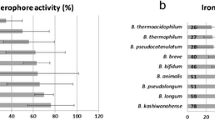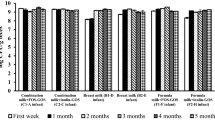Abstract
Fecal bacteria from 33 infants (aged 1 to 6 months) were tested for growth on commercial prebiotics. The children were born vaginally (20) or by caesarean section (13). Bifidobacteria, lactobacilli, gram-negative bacteria, Escherichia coli, and total anaerobes in fecal samples were enumerated by selective agars and fluorescence in situ hybridization. The total fecal bacteria were inoculated into cultivation media containing 2 % Vivinal® (galactooligosaccharides—GOS) or Raftilose® P95 (fructooligosaccharides—FOS) as a single carbon source and bacteria were enumerated again after 24 h of anaerobic cultivation. Bifidobacteria dominated, reaching counts of 9–10 log colony-forming units (CFU)/g in 17 children born vaginally and in seven children delivered by caesarean section. In these infants, lactobacilli were more frequently detected and a lower number of E. coli and gram-negative bacteria were determined compared to bifidobacteria-negative infants. Clostridia dominated in children without bifidobacteria, reaching counts from 7 to 9 log CFU/g. Both prebiotics supported all groups of bacteria tested. In children with naturally high counts of bifidobacteria, bifidobacteria dominated also after cultivation on prebiotics, reaching counts from 8.23 to 8.77 log CFU/mL. In bifidobacteria-negative samples, clostridia were supported by prebiotics, reaching counts from 7.17 to 7.69 log CFU/mL. There were no significant differences between bacterial growth on Vivinal® and Raftilose® P95 and counts determined by cultivation and FISH. Prebiotics should selectively stimulate the growth of desirable bacteria such as bifidobacteria and lactobacilli. However, our results showed that commercially available FOS and GOS may stimulate also other fecal bacteria.
Similar content being viewed by others

References
Biasucci G, Rubini M, Riboni S, Morelli L, Bessi E, Retetangos C (2010) Mode of delivery affects the bacterial community in the newborn gut. Early Hum Dev 86:S13–S15
Boehm G, Moro G (2008) Structural and functional aspects of prebiotics used in infant nutrition. J Nutr 138:1818S–1828S
Euler A, Mitchell DK, Kline R, Pickering LK (2005) Prebiotic effect of fructooligosaccharide supplemented term infant formula at two concentrations compared with unsupplemented formula and human milk. J Pediatr Gastroenterol Nutr 40:157–164
Harmsen HJ, Wildeboer-Veloo AC, Raangs GC, Wagendorp AA, Klijn N et al (2000) Analysis of intestinal flora development in brest-fed and formula-fed infants by using molecular identifibation and detection methods. J Pediatr Gastroenterol Nutr 30:61–67
Huurre A, Kalliomäki M, Rautava S, Rinne M, Salminen S, Isolauri E (2008) Mode of delivery—effect on gut microbiota and humoral immunity. Neonatology 93:236–240
Marques TM, Wall R, Ross RP, Fitzgerald GF, Ryan A, Stanton C (2010) Programming infant gut microbiota: influence of dietary and environmental factors. Curr Opin Biotechnol 21:149–156
Moro G, Minoli I, Mosca M, Fanaro S, Jelinek J, Stahl B, Boehm G (2002) Dosage related bifidogenic effects of galacto- and fructo-oligosaccharides in formula-fed term infants. J Pediatr Gastroenterol Nutr 34:291–295
Nakamura N, Gaskins HR, Collier CT, Nava GM, Rai D et al (2009) Molecular ecological analysis of fecal bacterial populations from term infants fed formula supplemented with selected blends of prebiotics. Appl Environ Microbiol 75:1121–1128
Niers L, Stasse-Wolthius M, Rombouts FM, Rijkers GT (2007) Nutritional support for the infant’s immune system. Nutr Rev 65:347–360
Penders J, Thijs C, Vink C, Stelma FF, Snijders B et al (2006) Factors influencing the composition of the intestinal microbiota in early infancy. Pediatrics 118:518–521
Rada V, Nevoral J, Trojanová I, Tománková E, Šmehilová M, Killer J (2008) Growth of infant fecal bifidobacteria and clostridia on prebiotic oligosaccharides in in vitro condition. Anaerobe 14:205–214
Vlková E, Nevoral J, Jenčíková B, Kopečný J, Godefrooij J, Trojanová I et al (2005) Detection of infant fecal bifidobacteria by enzymatic methods. J Mikrobiol Meth 60:365–373
Acknowledgments
This study was supported by grants GACR 525/08/H060 of the Grant Agency of the Czech Republic and MSM 60460709/01 of the Grant Agency of Ministry of Education, Youth and Sports of the Czech Republic.
Author information
Authors and Affiliations
Corresponding author
Rights and permissions
About this article
Cite this article
Bunešová, V., Vlková, E., Rada, V. et al. Growth of infant fecal bacteria on commercial prebiotics. Folia Microbiol 57, 273–275 (2012). https://doi.org/10.1007/s12223-012-0123-8
Received:
Accepted:
Published:
Issue Date:
DOI: https://doi.org/10.1007/s12223-012-0123-8



